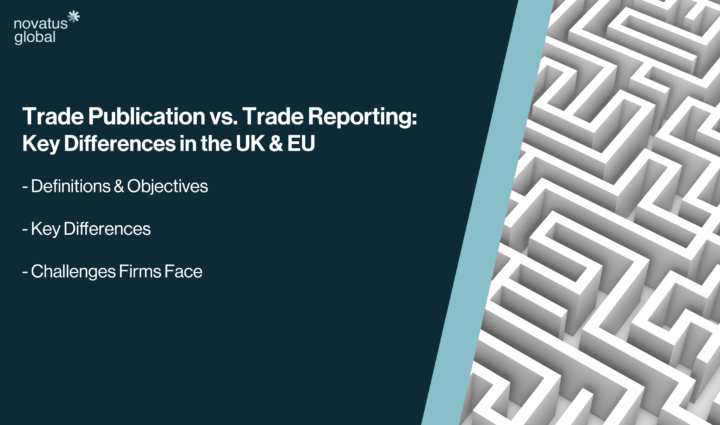
Trade Publication vs. Trade Reporting: Key Differences in the UK & EU
Trade publication and trade reporting are critical components of post-trade transparency and regulatory oversight. These obligations, introduced by MiFID II (Markets in Financial Instruments Directive II) and EMIR (European Market Infrastructure Regulation), aim to create a well-regulated financial market with robust investor protections. Despite their similar names, trade reporting and trade publication serve distinct purposes, have different audiences, and require varying data sets. Moreover, the divergence between EU and UK regulatory requirements adds complexity for firms operating in both jurisdictions.
This article outlines the key differences between trade publication and trade reporting, explores the evolving regulatory landscape post-Brexit, and highlights how firms can navigate these obligations.

Definitions and Objectives
Trade Reporting:
Trade reporting is the obligation for investment firms to report executed trades to regulators via Approved Reporting Mechanisms (ARMs) or trade repositories (TRs). The goal is to provide regulatory authorities with granular information on trading activities to monitor market abuse, systemic risk, and compliance. Trade reports must include key details such as:
-
- Financial instrument identifier (e.g. ISIN)
- Price, quantity, and currency
- Trade execution venue (e.g. regulated market, MTF, OTF)
- Counterparty details, including the Legal Entity Identifier (LEI)
Trade Publication:
Trade publication, or post-trade transparency, involves public dissemination of trade details, including price, volume, and time of execution. This is typically done via Approved Publication Arrangements (APAs). The objective is to ensure that market participants have timely access to trade data, thereby promoting market efficiency and price discovery. Unlike trade reporting, trade publication omits sensitive counterparty information.
Key Differences Between Trade Publication and Trade Reporting
| Aspect | Trade Reporting | Trade Publication |
| Objective | Regulatory oversight | Market transparency |
| Audience | Regulators | General public (investors, market participants) |
| Data Content | Comprehensive (includes counterparty details) | Limited (excludes counterparty details) |
| Timeframe | T+1 (next business day) | Near real-time |
| Obligation | MiFID II, EMIR | MiFID II |
Divergence Between EU and UK Reporting and Publication Post-Brexit
Since the UK’s departure from the EU, regulatory obligations for trade reporting and publication have diverged. While both the EU and UK retained MiFID II as the basis for their frameworks, the UK introduced modifications through the Financial Conduct Authority (FCA) to suit its independent regulatory environment.
Trade Reporting Differences:
-
-
- Approved Reporting Mechanisms (ARMs): Post-Brexit, firms operating in both the EU and UK may need to report trades to separate ARMs approved by the respective jurisdictions.
- Double Reporting Requirement: Transactions executed across the UK-EU border may require dual reporting, increasing operational complexity.
- Counterparty Location: Under MiFID II, the location of the counterparty affects reporting obligations. Firms must be vigilant in determining whether they are reporting to the correct regulator.
-
Trade Publication Differences:
-
-
- APAs: Firms trading in both jurisdictions must use separate APAs authorised by the EU and UK. The divergence in authorised publication arrangements has led to additional operational costs and complexity in ensuring timely dissemination of trade data.
- Transparency Timing Rules: While near-real-time publication remains the standard in both regions, minor timing differences and exemptions for certain illiquid instruments require careful tracking by compliance teams.
-
Challenges Firms Face with Trade Reporting & Publication Compliance
Managing trade reporting and publication across multiple jurisdictions presents several challenges:
-
-
- Operational Complexity: Firms must maintain separate systems for EU and UK reporting and publication, ensuring data consistency and accuracy across both regimes.
- Regulatory Divergence: Staying abreast of evolving rules in both jurisdictions is essential, as further divergence is likely over time.
- Data Accuracy: Ensuring high-quality, error-free data is critical to avoid regulatory penalties. Given the volume of fields required in trade reporting—especially for complex instruments like derivatives—errors can be costly.
- Latency in Trade Publication: Meeting near-real-time publication requirements is particularly challenging for firms with high trading volumes or operations across different time zones.
-
How Novatus Global Can Help
Navigating the complex landscape of trade reporting and publication across the EU and UK requires expertise, robust systems, and a proactive approach to regulatory changes. At Novatus Global, we offer tailored solutions to help firms manage these obligations efficiently:
-
-
- Multi-Jurisdictional Compliance Support: We provide end-to-end reporting and publication solutions for firms operating in both EU and UK markets, ensuring seamless compliance with MiFID II and EMIR requirements.
- Automated Reporting Solutions: Our technology-driven services minimise manual errors, streamline data submission, and ensure timely reporting across all required fields.
- Expert Advisory Services: Our regulatory experts monitor changes in both EU and UK regulations, offering proactive guidance to help clients stay compliant.
- Comprehensive Data Validation: We implement rigorous data validation processes to ensure accuracy and consistency, reducing the risk of reporting errors and associated penalties.
-
With Novatus Global’s expertise, firms can simplify their compliance processes, mitigate risks, and focus on their core business activities. Contact us today to learn more about how we can support your trade reporting and publication obligations.











